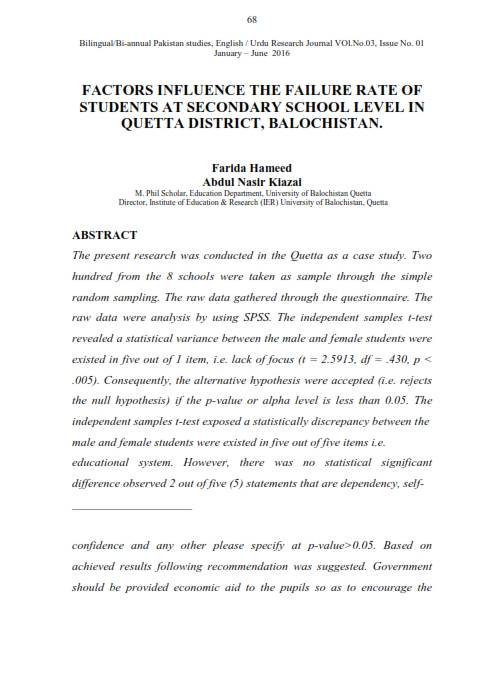FACTORS INFLUENCE THE FAILURE RATE OF STUDENTS AT SECONDARY SCHOOL LEVEL IN QUETTA DISTRICT BALOCHISTAN
Keywords:
factor, impact, failure, secoundary, school, Quetta.Abstract
The present research was conducted in the Quetta as a case study. Two
hundred from the 8 schools were taken as sample through the simple
random sampling. The raw data gathered through the questionnaire. The
raw data were analysis by using SPSS. The independent samples t-test
revealed a statistical variance between the male and female students were
existed in five out of 1 item, i.e. lack of focus (t = 2.5913, df = .430, p <
.005). Consequently, the alternative hypothesis were accepted (i.e. rejects
the null hypothesis) if the p-value or alpha level is less than 0.05. The
independent samples t-test exposed a statistically discrepancy between the
male and female students were existed in five out of five items i.e.
educational system. However, there was no statistical significant
difference observed 2 out of five (5) statements that are dependency, self-
confidence and any other please specify at p-value>0.05. Based on
achieved results following recommendation was suggested. Government
should be provided economic aid to the pupils so as to encourage the
parentages to send their offspring to school, college and university level in
order to falling the failure and dropout ratio. Parents should encourage
their children in the field of education so that to reduce the failure rate of
the students.
References
Ary, D., Jacobs L. C., &Razaveieh, A. (1996).Introduction to Research
Education.5th ed. New York: Holt, Rinehart and Winston,
Inc.
Fitzgibbon, C.T., & Morris, L. L. (1987). How to Design a Program
Evaluation. Newbury Park, CA: Sage.
Gay, L. R., & Mills G. E. (2006). Educational Research: Competencies for
Analysis and Applications5th ed. Upper Saddle River, N.J.:
Merrill/Prentice Hall.
GoP, (2015-16). Education (Chapter-10): Pakistan Economic Survey: Pp
-187.
Likert, R. (1932). A technique for the measurement of attitudes: Archives
of psychology. 22 (140), 1-55.
McCall, C. (1980).Sampling and statistics handbook for research in
education. National Education Association, USA.
Nunnally, J. C. (1967).Psychometric theory. New York: McGraw-Hill.
Trochim, W. M. (2000). The Research Methods Knowledge Base, 2nd
Edition. Atomic Dog Publishing, Cincinnati, OH.



